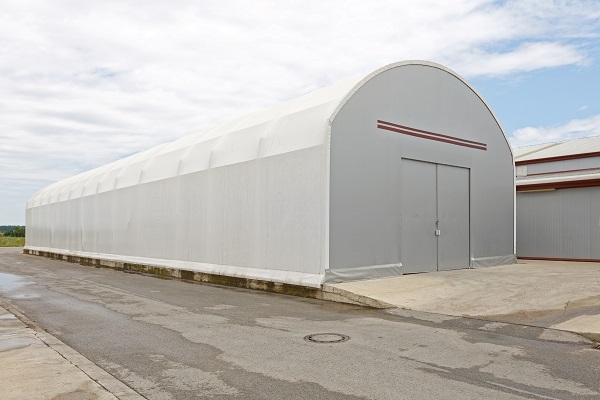The idea of utilizing materials stretched across a framework to create lightweight yet robust buildings isn’t new.
Ancient buildings like the teepees and yurts have been constructed for millennia, and engineered fabric buildings are based on the same concepts that made such structures effective.
Nowadays, they’re commonly used to house industrial enterprises, sporting facilities, and entertainment centers. Moreover, they have a variety of benefits over traditional steel and concrete structures for both temporary and permanent installations.
Industrialized structures like mining fabric buildings have taken advantage of the technology’s efficiency and durability over harsh climates.
These tensile buildings are three-dimensional surfaces made from a membrane that can produce a roof, shade, or ornamental components. They’re very flexible structures that are beneficial in a variety of ways.
Here are the five things that you should know about fabric buildings.
Set Up And Relocation Is Easy
Fabric structures are generally three times faster to erect than traditional structures. Although they might be built to be movable, they are typically permanent. It’s simple to roll up and transport the flexible fabric to a new spot as needed.
In comparison to steel sheeting, which requires .04 – .07 hours per square foot, most fabric buildings require .02 -.03 hours per square foot to be built.
Contrary to popular belief, fabric buildings are subject to different architectural regulations and loadings than typical metal structures. Designers employ the same engineering as the metal construction industry does. They can be built on various foundations, including screw piles, helical foundations, and precast or cast-in-place concrete.
They Are Durable
For decades, the robust steel frame has been utilized in all forms of building construction. Fabric buildings with rigid frame designs can withstand increased pressures on the structure, like conveyors and cranes, while still meeting local regulations against seismic activity, snow, and wind.
Fabric structures employ fungicide-resistant textiles to help keep it clean in the case of humid and wet weather for lengthy periods, preventing mold and further damage.
Other construction materials aren’t meant to survive as long as architectural fabric. Fabric structures are resistant to the weather since they don’t require screws or nails along the roof, keeping moisture from entering and causing rust or corrosion.
Fabric constructions’ steel support beams and trusses are generally galvanized to prevent them from rust and corrosion. Finally, there are fire-resistant fabrics available in the market, which are also resistant against the sun’s UV rays.
It’s Sustainable And Recyclable
Architectural fabric constructions provide a lot of advantages when it comes to sustainability. The first consideration is that fabric construction is incredibly light, allowing you to cover huge areas with minimal mass. Producing architectural textiles and delivering them to the construction site uses fewer raw materials and consumes less energy. These architectural materials, furthermore, they’ll endure 20 years or more, giving you a long life with low bulk and energy usage.
At the end of its life, many essential components of an architectural fabric structure are recyclable or reusable. Metal frames or steel masts and cables make up most of the mass in many of these buildings. These metal pieces like aluminum and steel may be recycled easily. Many architectural materials are also recyclable; however, they are more commonly reused for other purposes.
They Save Energy
The costs of heating and cooling a steel and concrete area are substantially cheaper with fabric structures. The interior of a fabric structure will stay cooler on hot days and warmer on cold days since the fabric materials are inherently non-conductive. Instead of retaining heat from the sun, the cloth helps to keep the inside temperature more consistent.
When properly constructed, architectural fabric buildings may be as energy-efficient as conventional structures. Full insulation and wide translucent fabric panels allow enough natural light to enter the space, eliminating the need for artificial lighting. Solar panels may be included in a fabric building design to help offset energy expenses even further.
It Has Multiple Applications
Fabric structures are commonly used to store or shelter outdoor equipment, automobiles, RVs, boats, bicycles, and gardening tools. Even some people create their outdoor workstations for their small businesses or hobbies using fabric structures. Fabric buildings may be built to fulfill a wide range of requirements, including different roof slopes and peak heights.
There are fabric structures with widths of over 300 feet and over 1000 feet for storing or housing various materials. Variable column heights, offset peaks, canopies, lean-tos, and mono-slope roofs can all be added to rigid steel frames. Additional structural components such as hangar doors, fire suppression systems, cranes, and conveyors can all be supported by steel frames in fabric structures.
The Takeaway
There are several advantages to erecting fabric buildings instead of typical brick and mortar structures. It can cover a big area and accommodate many people, making it perfect for building greenhouses, playing, viewing, working, and socializing. It’s also a good choice for industrial structures because of its durability and ability to be moved more rapidly than other materials. Overall, fabric structures are a fantastic innovation that may benefit people in industrial, commercial, and social settings.
Also Read
8 Benefits of Using a Construction Estimating Software for your Construction Projects
What Kind of Wood Is Better to Build a House

